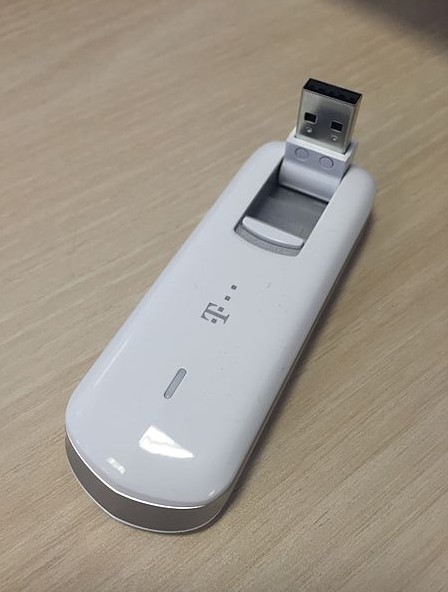USB modems, also known as wireless modems or mobile broadband modems, are a modern convenience that allows us to connect to the Internet anywhere we bring our device. The USB modem is a small and portable USB (universal bus service) device – usually the size of a typical USB flash drive – that functions as a modem and plugs into a laptop or a desktop computer. It provides a way to receive Internet access via a mobile broadband connection instead of cable television or telephone lines. The user can connect using a wireless modem to a wireless Internet Service Provider (ISP) to get internet access.
USB Modem History
The term “modem” is a portmanteau of “modulator-demodulator,” which is a hardware device that converts data from a digital format. Its goal is to produce a signal that can be easily transmitted and decoded to reproduce the original digital data sent from one device to another.
The most common type of modem that we use today turns digital data from a computer or device to a modulated electrical signal for transmission over telephone lines. The transmitted data is then demodulated by another modem at the receiver side to receive the digital data.
Analog mobile phones before provided a standard RJ11 telephone socket into which a landline modem could be plugged. However, it offered slow dial-up connections. The next generation of phones, the 2G phones, were digital and came with faster dial-up speeds of 9.6kbit/s or 14.4kbit/s without needing a separate model. Both devices still needed their users to have a dial-up ISP to connect to the Internet.
When 2.5G phones were released, things changed. These phones have support for packet data. The 2.5G networks break both voice and data into small chunks and mix both unto the network simultaneously. It allows the phone to have a voice connection and a data connection at the same time. It also enables web browsing to be possible on the phone, but a PC can also tap into this connection if it connects to the phone. The network speeds on 2.5G networks are typically in the 30-50kbit/s range.
The 3G technology has taken this approach to a higher level, as it can provide speeds over 300kbit/s. Due to increased internet speed, connection sharing via WLAN became possible. When the 3.5G technology was released, it provided speeds of multiple megabits per second. Most mobile network operators that offer 3G or faster wireless internet access provide USB modems and plans that enable computers to connect and access the Internet. The USB modems act as a Wi-Fi hotspot to enable multiple devices to connect to the Internet.
How to Use a USB Modem
A USB modem offers dial-up capabilities to connect to the Internet using a wireless network. It provides network sharing among multiple users or devices simultaneously. Installing the modem can take just a few minutes, enabling you to enjoy the Internet instantly. Here’s how to use it:
- Connect your USB modem to a USB port on your computer. The operating system on your Windows computer will automatically detect and install drivers for you. After installing, click the Start button, and look for the “Control Panel.” Click the “Network and Internet” and then click “Network and Sharing Center” to open the network settings.
- Click “Set up a connection or network.” The link starts the wizard for setting up a dial-up connection to your Internet service provider. Click “Set up a dial-up connection” so you can choose the modem setup. Choose “Next.”
- Type your username, dial-up number, and password into the text boxes. Your ISP will provide these values. Type a unique name for your protection into the connection name text box, and this will be the name displayed when you view all your internet connections.
- Click “Connect.” The USB modem will dial your ISP’s number and connect to the servers. Click “Browse the Internet now” to open your default browser. You can now browse the Internet by typing in a website name on the Web browser address text box.
This is just a general way to use a USB modem. It’s best to refer to your modem’s instructions on how to use it.
Advantages of USB Modems
A portable modem has several advantages that it can offer to users, including:
Convenience – Since USB modems are very compact in size, they easily fit in the pocket and use it on the go. It’s also easy to set up, and it’s not complicated to create your own local network. These modems are also compatible with almost all modern smartphones, tablets, laptops, and other devices.
Secure connection – A personal modem has a built-in firewall that protects users against external attacks from the Internet. It means it can prevent unauthorized access to the computer. Connecting via public Wi-Fi can be dangerous for your personal data.
Ability to offer simultaneous Internet access – Through a USB modem, you can create multiple subnets to provide simultaneous Internet access for up to 10 devices.
Wireless – Since USB modems connect to your laptop or computer, they can work without electricity and do not risk running low on energy as with modems with built-in batteries. When using a USB modem, you don’t need to connect additional power cords.
Travel-friendly – If you’re a person on the go or need to secure Internet connectivity as you travel, these portable routers can help you with your needs. This tiny device is also convenient to take with you on business trips and presentations at work to ensure that you’re always connected anywhere you are.
